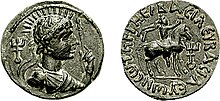Kushana coinage
The coinage of the Kushana in Central Asia and India developed from that of the Indo-Greeks and Indo-Scythians . The kingdom of the Kushana was the most important in Central Asia and Northern India from the first to third centuries AD. The wealth of the empire is underlined above all by the numerous gold coins.
Before the first actual coins of the Kushana were minted in Central Asia, there were mints in northern Bactria that copied those of the Indo-Greek rulers Eukratides I and Heliocles I. Those of the latter were produced from around the end of the second century BC to the first half of the first century AD. They bore a portrait of the ruler and on the back an image of a Greek deity. They are bronze embossings. Over time, the image of Heliocles was replaced by that of local rulers. However, the Greek legends became more and more illegible.
The first specific Kuschana imprints come from Vima Takto . The image of the deity on the back has been replaced by the image of a rider. The Greek legends are: King of Kings, the great Redeemer . A new type of coin emerged under Vima Kadphises , which is documented until the end of the Kushana rule. On the front, the standing ruler appears next to an altar, while on the back there is an image of a deity. They are seldom Greek deities. Instead, Shiva and Iranian deities are well attested. Buddha rarely appears on the coins, although Buddhism flourished in the Kushana kingdom. While most of the early Kushana coins were made of bronze, coinage has been based on the gold staters since Vima Kadphises . They usually weigh 8 grams, but there were also double, half or quarter staters (16, 4, 2 grams).
The gold coins seem to have been used mainly in international trade. Bronze and copper coins, on the other hand, were used more locally and are therefore rarely found outside the borders of the Kushana Empire.
literature
- AR Mukhamedjanov: Economy and social system in Central Asia , in: János Harmatta u. a. (Ed.): The development of sedentary and nomadic civilizations. 700 BC to AD 250 . Unesco, Paris 1994, ( History of Civilizations of Central Asia 2), ISBN 92-3-102846-4 , 265-290
- R. Göbl: System and chronology of the coinage of the Kušānreiches , Vienna 1984, ISBN 3-7001-0618-1

